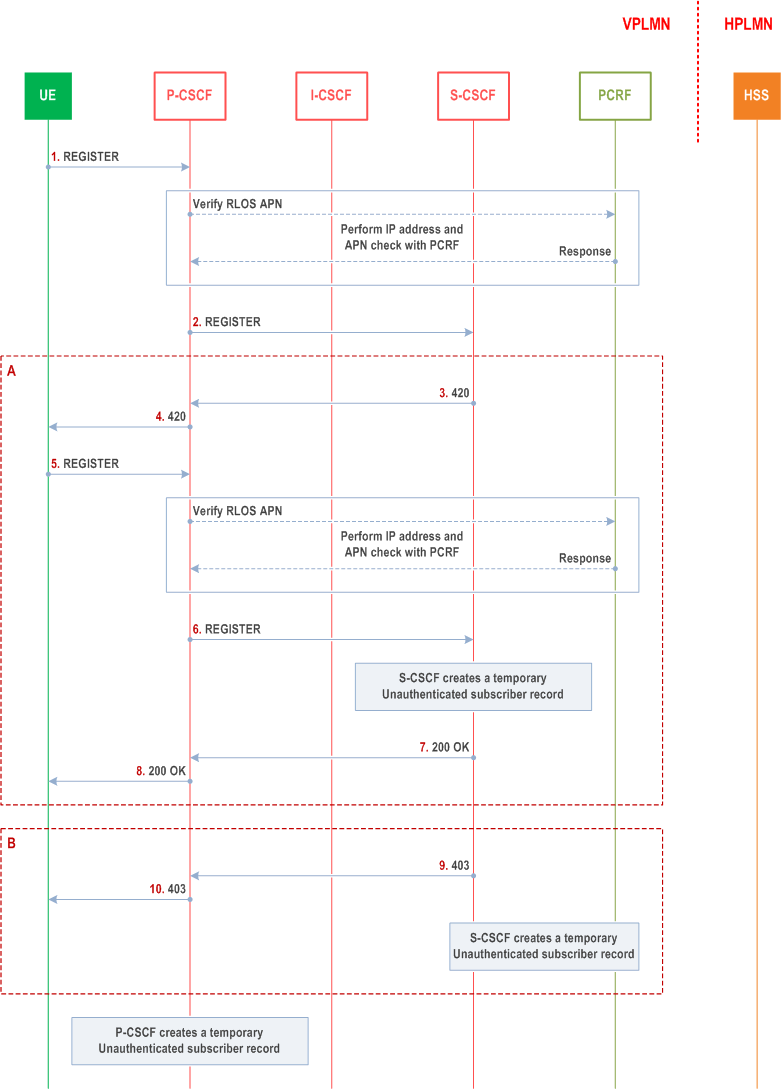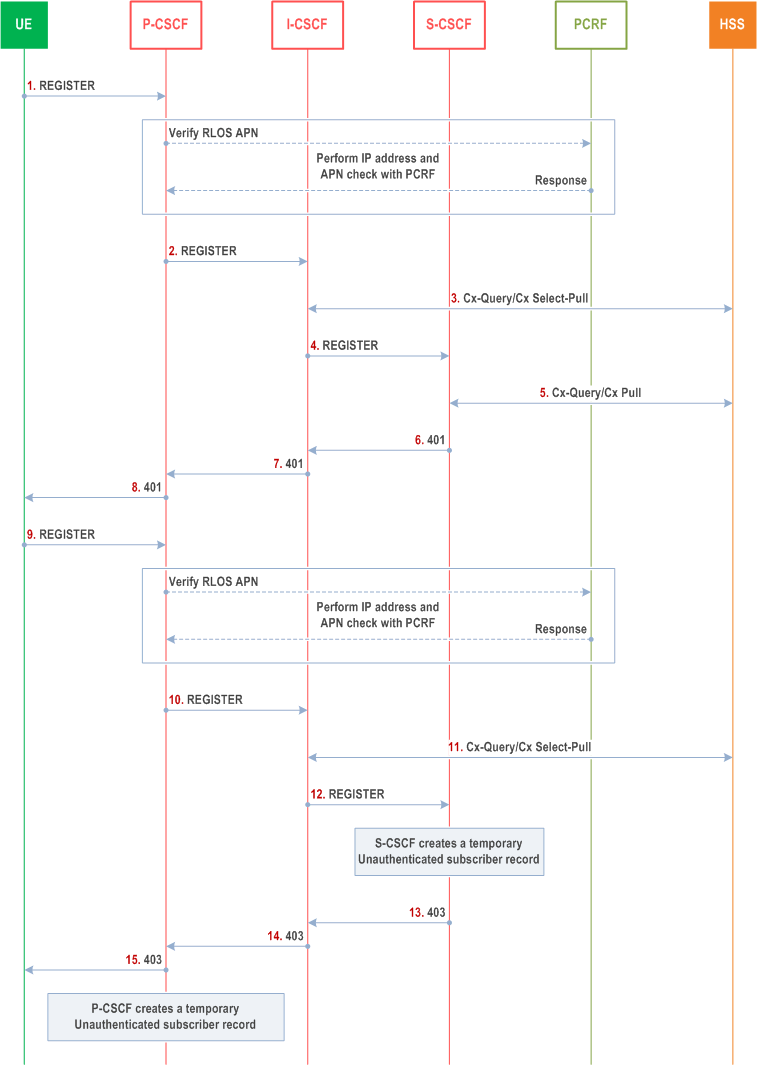Content for TS 23.228 Word version: 18.6.0
1…
3…
4…
4.2.4…
4.3…
4.4…
4.13…
4.16…
5…
5.2…
5.3…
5.4…
5.4.7…
5.4.8…
5.4a…
5.5…
5.5.3…
5.6…
5.6.3…
5.7…
5.7.3…
5.7.5…
5.7.8…
5.8…
5.10…
5.11…
5.11.3…
5.11.3.3
5.11.3.4
5.11.4…
5.11.5…
5.11.5.3…
5.11.6…
5.12…
5.16…
5.16.2…
5.19…
5.20…
A…
E…
E.2.2…
G…
G.5…
H
I…
J…
K…
L…
M…
M.3…
N…
P…
Q…
Q.2.5…
R…
S…
T…
U…
U.2…
V…
W…
X…
Y…
Z…
AA…
AA.3…
AB…
AC…
AC.7…
AC.7.2…
AC.7.2.2
AC.7.2.3…
AC.7.4…
AC.9…
Z Support of IMS-based Restricted Local Operator Services (RLOS)
Z.1 General
Z.2 Architecture
Z.3 IMS Registration to access RLOS
Z.3.1 RLOS IMS Registration for Roaming users (no roaming Agreements with home network)
Z.3.2 RLOS IMS Registration for Operator own subscribers and Roaming users with roaming agreements with their home network
Z.3.2.1 Unsuccessful IMS Registration
Z.3.2.2 Successful IMS Registration
Z.3.3 RLOS APN Verification
Z.4 IMS-based RLOS Session Initiation
...
...
Z (Normative) Support of IMS-based Restricted Local Operator Services (RLOS) |R16| p. 338
Z.1 General p. 338
This clause describes the required functions to support IMS-based restricted local operator services (RLOS). RLOS services are operator owned services that are offered to the following categories of subscribers:
- Roaming users who are subscribers of other operators with whom the local operator has no roaming agreement, or the local operator cannot communicate with their network.
- Roaming users who are subscribers of other operators with whom the local operator has roaming agreements for IMS services and for Restricted Operator Local Services.
- Operator own subscribers who roamed in cells with restricted services. These subscribers may or may not have been successfully authenticated prior to roaming in cells with restricted services.
Z.2 Architecture p. 338
Support for RLOS requires additional functionalities in the P-CSCF, I- CSCF, and S-CSCF as will be depicted below. The additional functionality can be built on the existing functionality to support RLOS and non-RLOS IMS services. Optionally, dedicated IMS nodes (P/I/S-CSCFs) supporting only RLOS can be deployed.
Z.3 IMS Registration to access RLOS p. 339
Z.3.1 RLOS IMS Registration for Roaming users (no roaming Agreements with home network) p. 339

Step 1.
Steps 3-8 apply if the S-CSCF has responded with 420 response.
After the UE has obtained IP connectivity (as defined in TS 23.401 for RLOS users), it performs regular IMS registration and includes an indication that this is an RLOS related IMS registration in the Register information.
Step 2.
The P-CSCF is a P-CSCF that supports RLOS, and upon receipt of the Register information, optionally, and based on operator policy performs the security checks in clause Z.3.3. Based on the subscriber being a roaming user without roaming agreement with his home network, and the RLOS indication in the Register information, the P-CSCF shall send the Register information to the S-CSCF configured in the P-CSCF to handle RLOS users.
Step 3.
Steps 9-10 apply if the S-CSCF has responded with 403 response.
Upon receipt of the Register information, the S-CSCF, based on the RLOS indication and the subscriber being a roaming user without roaming agreement with his home network and depending on the network configuration, and if the network supports GIBA, sends back a 420 response with sec-agree value listed in the unsupported header field.
Step 4.
The P-CSCF forwards the 420 response to the UE.
Step 5.
The UE initiates a new Register request and does not include the Authorization header field.
Step 6.
The P-CSCF optionally performs the RLOS APN verification in clause Z.3.3, then sends the Register information to the S-CSCF allocated to the UE.
Step 7.
Upon receipt of the Register information, the S-CSCF shall accept the Registration, creates a temporary record for the unauthenticated UE with a default service profile and responds with a 200 OK.
Step 8.
The P-CSCF sends the 200 OK to the UE.
Step 9.
Upon receipt of the Register information, the S-CSCF, based on the RLOS indication and the subscriber being a roaming user without roaming agreement with his home network and depending on the network configuration as well as operator configuration (no support for GIBA), responds with a 403 response. The S-CSCF creates a temporary registration record for the unauthenticated UEs with a default service profile.
Step 10.
The P-CSCF sends the 403 response to the UE. The P-CSCF creates a temporary registration record for the unauthenticated UE given that the subscriber is a roaming user without roaming agreement with his home network. The UE is allowed to initiate an IMS session.
Z.3.2 RLOS IMS Registration for Operator own subscribers and Roaming users with roaming agreements with their home network p. 340
Operator own subscribers, and/or roaming users with IMS services and Restricted Local Operator Services roaming agreement with their home network, shall perform a new IMS registration, as specified below, to access IMS-based Restricted Local Operator Services upon roaming in cells with restricted services. The UE shall also delete any valid IMS registration performed by the UE prior to roaming in cells with restricted services.
Z.3.2.1 Unsuccessful IMS Registration p. 341

Step 1.
After the UE has obtained IP connectivity (as defined in TS 23.401 for RLOS users), it performs regular IMS registration and includes an indication that this is an RLOS IMS related registration in the Register information.
Step 2.
The P-CSCF is a P-CSCF that supports RLOS, and upon receipt of the Register information optionally, and based on operator policy, performs the RLOS APN verification in clause Z.3.3. The P-CSCF based on the RLOS indication and the subscriber being its own subscriber sends the Register information to the I-CSCF.
Step 3.
The I-CSCF queries HSS for the subscriber S-CSCF. If the I-CSCF determines based on configuration that the received S-CSCF does not support RLOS and since this is an RLOS related registration, the I-CSCF queries HSS again for required S-CSCF capabilities in the user profile. The I-CSCF shall use the returned S-CSCF capability information and in addition configured information about S-CSCF support for RLOS to select a S-CSCF.
Step 4.
The I-CSCF sends the Register information to the selected S-CSCF.
Step 5.
The S-CSCF fetches the authentication information from HSS.
Step 6.
The S-CSCF challenges the UE by sending a 401 response.
Step 7.
The I-CSCF forwards the 401 response to the P-CSCF.
Step 8.
The P-CSCF forwards the 401 response to the UE.
Step 9.
The UE sends a new Register request to the P-CSCF including the authentication information.
Step 10.
The P-CSCF optionally and based on operator policy, performs the RLOS APN verification in clause Z.3.3, then sends the Register information to the I-CSCF.
Step 11.
The I-CSCF queries HSS for the subscriber S-CSCF and receives the S-CSCF name allocated to the UE. If the I-CSCF determines based on configuration that the received S-CSCF does not support RLOS and since this is an RLOS related registration, the I-CSCF queries HSS again for required S-CSCF capabilities in the user profile. The I-CSCF shall use the returned S-CSCF capability information and in addition configured information about S-CSCF support for RLOS to select a S-CFCF.
Step 12.
The I-CSCF sends the Register information to the selected S-CSCF.
Step 13.
The S-CSCF validates the UE received authentication information but failed to successfully authenticate the UE. Since this is an RLOS related IMS registration, the S-CSCF creates a temporary "unauthenticated subscriber" registration record for the UE with a default service profile and responds with a 403 response.
Step 14.
The I-CSCF sends the 403 response to the P-CSCF.
Step 15.
The P-CSCF sends the 403 response to the UE, and creates a temporary "unauthenticated subscriber" registration record for the UE.
Z.3.2.2 Successful IMS Registration p. 342
A successful IMS registration is identical to the failed one with following exceptions:
- The S-CSCF successfully authenticates the UE in step 12.
- The S-CSCF tags the UE registration record as being successfully RLOS registered.
- The S-CSCF updates HSS with the S-CSCF name being allocated to the UE, downloads the UE profile from HSS, and stores it. This step is not performed in the previous case.
- The P-CSCF tags the UE registration record as being successfully RLOS registered.
Z.3.3 RLOS APN Verification p. 342
The P-CSCF may be configured with a range of IP addresses dedicated to UEs requesting access to RLOS. These addresses, if configured, shall be checked against the contact information received by the P-CSCF Register information at IMS registration.
Furthermore, the P-CSCF shall validate that an incoming IMS registration did indeed use the APN dedicated to RLOS by the access network. To that effect, the P-CSCF shall indicate to the PCRF that the UE requests access to RLOS. The PCRF shall then validate whether the UE uses the APN dedicated to RLOS and otherwise reject the related Rx session with the indication that the UE is not using the APN dedicated to RLOS. Upon reception of such an indication from the PCRF, the P-CSCF shall reject the IMS registration.
Z.4 IMS-based RLOS Session Initiation p. 343
Clause 5.6.2 applies with the following additional requirements:
- The UE shall include an RLOS indication in all originating sessions. The P-CSCF shall reject an originating session without such an indication.
- The S-CSCF shall include the RLOS indication in its charging data related to an IMS session.
- The S-CSCF shall forward the session initiation request to the Telephony Application Server. The Telephony Application Server shall bypass originating services for all successfully authenticated UEs. The Telephony Application Server, based on operator policy, may be configured with different policies (e.g. set of destinations) for all of the above registration cases. The Telephony Application Server shall enforce these policies.
- The S-CSCF shall include the RLOS indication in its charging data related to an IMS session.
- The registered identity shall be used as the asserted identity.